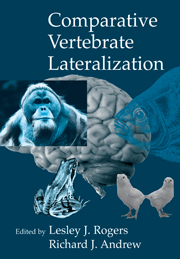Book contents
- Frontmatter
- Contents
- List of Contributors
- Preface
- Introduction
- Part one Evolution of lateralization
- Part two Development of lateralization
- Part three Cognition and lateralization
- Part four Lateralization and memory
- 14 Memory and lateralized recall
- 15 Memory formation and brain lateralization
- Epilogue
- Author Index
- Subject Index
- Richard Andrew
15 - Memory formation and brain lateralization
Published online by Cambridge University Press: 10 December 2009
- Frontmatter
- Contents
- List of Contributors
- Preface
- Introduction
- Part one Evolution of lateralization
- Part two Development of lateralization
- Part three Cognition and lateralization
- Part four Lateralization and memory
- 14 Memory and lateralized recall
- 15 Memory formation and brain lateralization
- Epilogue
- Author Index
- Subject Index
- Richard Andrew
Summary
Introduction
Johnston and Rose (Chapter 14) review extensive evidence that processes of memory formation are markedly asymmetrical in the chick. Asymmetrical involvement of brain structures in memory formation and recall is now well established for humans, as will be shown in Section 15.11 of this chapter.
I argue here that in birds (and probably other non-mammalian vertebrates) left–right differences in brain function, coupled with the common occurrence of independent viewing by the two eyes, result in the initial establishment of right and left traces. These have different content, even though they derive from the same experience. The initial differences are altered during memory formation, as is revealed, for example, by what is available to recall. In the chick, at least, much of this change is caused by processes initiated at ‘retrieval events’. These are cyclically recurring points of trace reactivation; the cycles have different periods in right and left hemispheres.
The terms right or left eye systems (RES, LES) will be used, when evidence for left–right differences consists of differences in spontaneous eye use or differences between performance with right or left eye (RE, LE). This avoids the implication that structures which are exclusively contralateral to the eye in use are the only ones involved.
- Type
- Chapter
- Information
- Comparative Vertebrate Lateralization , pp. 582 - 633Publisher: Cambridge University PressPrint publication year: 2002
- 4
- Cited by



